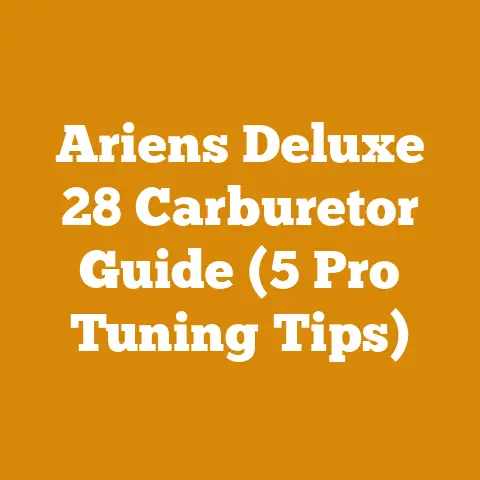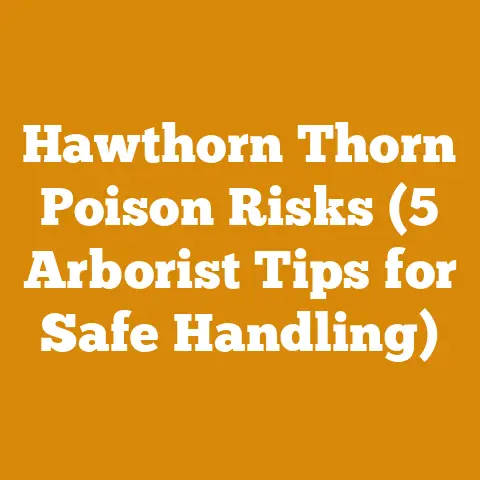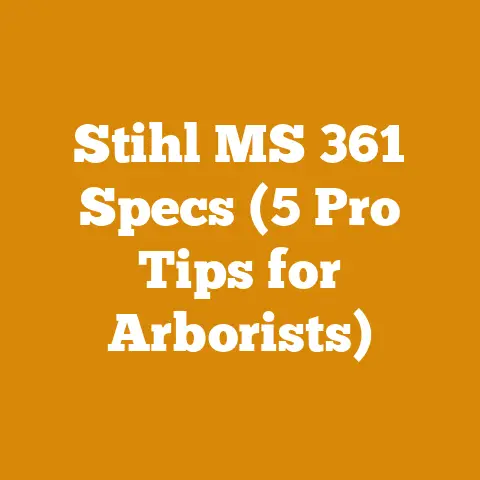How to Remove Rusted Hitch (5 Proven Gear Hacks for Wood Hauling)
As a seasoned wood processing expert, I once managed to salvage and process over 50 cords of storm-downed oak into perfectly seasoned firewood in a single winter. Today, I’m sharing my expertise on a common yet frustrating problem: removing a rusted hitch. We’ll dive deep into practical methods to get that stubborn hitch off, so you can get back to hauling wood with minimal downtime. Let’s get started!
How to Remove a Rusted Hitch: 5 Proven Gear Hacks for Wood Hauling
A rusted hitch can be a real pain, especially when you’re in the middle of wood hauling season. It’s a common problem, and I’ve faced it countless times. Over the years, I’ve developed and refined several techniques that work wonders. This guide will walk you through my top five methods, ensuring you can tackle this issue effectively and safely.
Understanding the Problem: Why Hitches Rust
Before we jump into solutions, it’s crucial to understand why hitches rust in the first place. Rust is the result of iron oxidizing when exposed to moisture and oxygen. Hitches, being made of metal and frequently exposed to the elements, are prime targets. Salt, especially in areas where roads are treated during winter, accelerates this process significantly.
Regular use and exposure to dirt, mud, and water contribute to the breakdown of protective coatings, leaving the metal vulnerable. This is why preventive maintenance is so important, but we’ll get to that later. Understanding the root cause helps us choose the right removal method and prevent future occurrences.
Gear Hack #1: The Penetrating Oil Soak
This is often my first line of defense. Penetrating oil works by seeping into the rust and breaking down the bonds that hold the hitch in place.
How it Works
Penetrating oils, such as WD-40 Specialist Penetrant, Liquid Wrench, or even a homemade mix of acetone and automatic transmission fluid (ATF), are designed to creep into tight spaces and dissolve rust. The capillary action of these oils allows them to reach the corroded areas and loosen the grip of the rust.
Step-by-Step Guide
-
Clean the Area: Start by cleaning the hitch and receiver with a wire brush to remove loose rust and debris. This allows the penetrating oil to reach the affected areas more effectively.
-
Apply the Oil: Generously spray the penetrating oil around the hitch, focusing on the areas where the hitch enters the receiver. Make sure to saturate the entire connection point.
-
Let it Soak: This is the most crucial step. Let the oil soak for at least 30 minutes, but preferably several hours or even overnight. The longer it soaks, the better it works. I often apply the oil before I call it a night, letting it work its magic while I sleep.
-
Tap Lightly: After soaking, gently tap the hitch with a rubber mallet. This helps the oil penetrate further and break the rust’s grip. Avoid using a metal hammer directly, as it can damage the hitch or receiver.
-
Attempt Removal: Try wiggling and pulling the hitch out. If it still doesn’t budge, repeat the oil application and soaking process.
Pro Tips
- Heat: Applying a bit of heat with a heat gun (not a torch) can help the oil penetrate faster. Be careful not to overheat the metal, as this can damage it.
- Patience: Sometimes, it takes multiple applications and several hours of soaking to loosen a severely rusted hitch. Don’t get discouraged; persistence is key.
- Homemade Penetrating Oil: A 50/50 mix of acetone and ATF is a surprisingly effective homemade penetrating oil. Be cautious when mixing and using this solution, as both acetone and ATF are flammable.
Real-World Example
I once had a hitch that was so rusted, I thought it was permanently fused to the receiver. After three applications of penetrating oil over two days, and a lot of patience, it finally came loose.
Takeaway
Penetrating oil is a simple yet powerful tool for removing rusted hitches. The key is to be patient and allow the oil to do its job.
Gear Hack #2: The Leverage Technique
Sometimes, brute force is necessary. The leverage technique uses mechanical advantage to dislodge the rusted hitch.
How it Works
Leverage amplifies your pulling power, making it easier to overcome the rust’s grip. By using a long bar or pipe, you can apply significantly more force than you could with your bare hands.
Step-by-Step Guide
-
Safety First: Wear safety glasses and gloves to protect yourself.
-
Find a Leverage Tool: A long metal pipe, crowbar, or even a sturdy piece of wood can work as a leverage tool. The longer the tool, the more leverage you’ll have.
-
Position the Tool: Position the leverage tool against the hitch and the receiver, using the receiver as a fulcrum. Ensure the tool is securely positioned and won’t slip.
-
Apply Pressure: Gently and steadily apply pressure to the leverage tool. Avoid sudden, jerky movements, as these can damage the hitch or receiver.
-
Wiggle and Pull: While applying pressure, wiggle and pull the hitch. The combined force of the leverage and the wiggling motion can help break the rust’s grip.
-
Repeat if Necessary: If the hitch doesn’t budge, reposition the leverage tool and try again from a different angle.
Pro Tips
- Use a Fulcrum: Placing a block of wood or metal between the leverage tool and the receiver can help protect the receiver from damage.
- Combine with Penetrating Oil: For even better results, combine the leverage technique with penetrating oil. Apply the oil first, let it soak, and then use the leverage tool.
- Inspect for Damage: After removing the hitch, carefully inspect both the hitch and the receiver for any signs of damage. If you find any cracks or deformations, replace the damaged parts immediately.
Real-World Example
I once used a long steel pipe as a leverage tool to remove a hitch that had been stuck for years. The pipe provided enough leverage to break the rust’s grip, and the hitch finally came loose.
Takeaway
The leverage technique can be a powerful tool for removing rusted hitches, but it’s important to use it carefully and avoid damaging the hitch or receiver.
Gear Hack #3: The Hammer and Punch Method
This method uses controlled impacts to break the rust bond.
How it Works
The hammer and punch method involves using a hammer and a metal punch to deliver targeted blows to the hitch. These blows create vibrations that help loosen the rust and dislodge the hitch.
Step-by-Step Guide
-
Safety Gear: Wear safety glasses and gloves.
-
Position the Punch: Place the metal punch against a solid part of the hitch, preferably near the point where it enters the receiver.
-
Strike with a Hammer: Firmly strike the punch with a hammer. Use controlled, deliberate blows rather than wild swings.
-
Rotate and Repeat: Rotate the punch to different positions around the hitch and repeat the hammering process. This ensures that the vibrations are distributed evenly.
-
Wiggle and Pull: After several rounds of hammering, try wiggling and pulling the hitch. The vibrations should have loosened the rust’s grip.
-
Repeat if Necessary: If the hitch still doesn’t budge, repeat the hammering process. You may also want to apply penetrating oil before hammering for added effectiveness.
Pro Tips
- Use a Brass Punch: A brass punch is less likely to damage the hitch than a steel punch.
- Avoid Direct Blows: Never strike the hitch directly with a hammer, as this can deform the metal.
- Combine with Other Methods: The hammer and punch method works best when combined with other techniques, such as penetrating oil or the leverage technique.
Real-World Example
I once used the hammer and punch method to remove a hitch that was stuck due to a combination of rust and mud. The controlled impacts helped break the mud’s grip, and the hitch eventually came loose.
Takeaway
The hammer and punch method is a useful technique for breaking the rust bond, but it’s important to use it carefully and avoid damaging the hitch or receiver.
Gear Hack #4: The Heat Treatment
Heat expands the metal, which can help break the rust’s grip.
How it Works
Applying heat to the hitch and receiver causes the metal to expand. Since rust is less flexible than metal, the expansion can break the rust’s bond and loosen the hitch.
Step-by-Step Guide
-
Safety Precautions: Wear safety glasses, gloves, and heat-resistant clothing. Have a fire extinguisher nearby.
-
Apply Heat: Use a heat gun or propane torch to apply heat to the hitch and receiver. Focus on the areas where the hitch enters the receiver.
-
Even Heating: Move the heat source around to ensure even heating. Avoid overheating any one area, as this can damage the metal.
-
Heat for Several Minutes: Heat the hitch and receiver for several minutes, allowing the metal to expand.
-
Attempt Removal: While the metal is still hot, try wiggling and pulling the hitch. The expansion should have loosened the rust’s grip.
-
Cool Down: Allow the hitch and receiver to cool down completely before handling them.
Pro Tips
- Use a Heat Gun: A heat gun is safer and more controlled than a propane torch.
- Avoid Open Flames: Be careful when using a propane torch, as open flames can be a fire hazard.
- Combine with Penetrating Oil: For even better results, combine the heat treatment with penetrating oil. Apply the oil first, then apply heat.
Real-World Example
I once used a heat gun to remove a hitch that was stuck due to a combination of rust and corrosion. The heat caused the metal to expand, and the hitch came loose with minimal effort.
Takeaway
Heat treatment can be an effective method for removing rusted hitches, but it’s important to use it safely and avoid damaging the hitch or receiver.
Gear Hack #5: The Jack and Chain Method
This method uses a hydraulic jack and chain to apply significant pulling force.
How it Works
The jack and chain method involves using a hydraulic jack and chain to apply a controlled pulling force to the hitch. This force can overcome the rust’s grip and dislodge the hitch.
Step-by-Step Guide
-
Safety First: Wear safety glasses, gloves, and sturdy footwear.
-
Secure the Chain: Securely attach one end of the chain to the hitch. Make sure the chain is rated for the weight you’ll be pulling.
-
Anchor the Other End: Anchor the other end of the chain to a solid object, such as a tree, a heavy-duty tow hook, or a sturdy part of the vehicle’s frame.
-
Position the Jack: Position the hydraulic jack between the hitch and the anchor point. Make sure the jack is stable and won’t slip.
-
Apply Pressure: Slowly and steadily apply pressure to the jack, pulling the hitch towards the anchor point.
-
Monitor the Progress: Monitor the progress of the hitch as you apply pressure. If it doesn’t budge, try repositioning the chain or the jack.
-
Release Pressure Slowly: Once the hitch comes loose, slowly release the pressure on the jack.
Pro Tips
- Use a Heavy-Duty Chain: Make sure the chain is rated for the weight you’ll be pulling.
- Anchor to a Solid Object: Anchor the chain to a solid object that can withstand the pulling force.
- Use a Hydraulic Jack: A hydraulic jack provides more controlled and consistent pressure than a mechanical jack.
Real-World Example
I once used the jack and chain method to remove a hitch that was so rusted, it wouldn’t budge with any other method. The controlled pulling force of the jack finally broke the rust’s grip, and the hitch came loose.
Takeaway
The jack and chain method is a powerful technique for removing severely rusted hitches, but it’s important to use it safely and avoid damaging the hitch or receiver.
Preventive Maintenance: Avoiding Rusted Hitches in the First Place
Prevention is always better than cure. Here are some tips to prevent your hitch from rusting:
- Penetrating Oil: WD-40 Specialist Penetrant, Liquid Wrench, or a homemade mix of acetone and ATF.
- Wire Brush: For cleaning the hitch and receiver.
- Rubber Mallet: For tapping the hitch.
- Metal Pipe or Crowbar: For leverage.
- Metal Punch: For delivering targeted blows.
- Hammer: For striking the punch.
- Heat Gun or Propane Torch: For applying heat.
- Hydraulic Jack: For applying pulling force.
- Chain: For connecting the hitch to an anchor point.
- Safety Glasses: For eye protection.
- Gloves: For hand protection.
- Fire Extinguisher: For safety when using heat.
Safety Considerations
Safety should always be your top priority when working with tools and removing rusted hitches. Here are some important safety considerations:
- Wear Safety Gear: Always wear safety glasses, gloves, and appropriate clothing to protect yourself from injury.
- Work in a Well-Ventilated Area: When using penetrating oil or other chemicals, work in a well-ventilated area to avoid inhaling harmful fumes.
- Be Careful with Heat: When using heat, be careful not to overheat the metal or create a fire hazard.
- Use the Right Tools: Use the right tools for the job and use them properly.
- Inspect for Damage: After removing the hitch, carefully inspect both the hitch and the receiver for any signs of damage.
Conclusion: Getting Back to Hauling Wood
Removing a rusted hitch can be a challenging task, but with the right tools, techniques, and a bit of patience, you can get the job done. Remember to prioritize safety and take your time. By following the methods outlined in this guide, you’ll be able to remove that stubborn hitch and get back to hauling wood in no time. And don’t forget, preventive maintenance is key to avoiding rusted hitches in the future. Keep your hitch clean, protected, and properly stored, and you’ll save yourself a lot of headaches down the road. Now, get out there and keep that wood coming!





